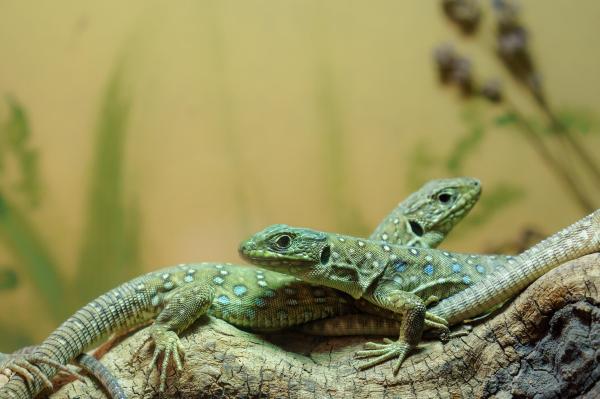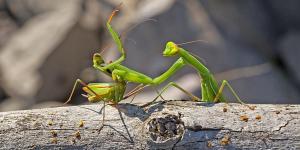How Do Lizards Reproduce?


From the parched sands of the desert to the lush canopies of tropical rainforests, lizards have mastered the art of survival, adapting to a wide range of environments. This taxonomic diversity extends to their reproductive strategies, with lizards showcasing a remarkable array of adaptations that enable them to thrive in their diverse habitats.
This AnimalWised article explores the reproductive strategies of lizards, examining their courtship rituals, mating behaviors, and egg-laying processes in detail.
What is the lizard mating strategy?
Lizard reproduction involves a fascinating array of species-specific courtship rituals. These intricate displays serve several crucial functions:
- Signaling readiness to mate: Vibrant colors, elaborate dances, and vocalizations like chirps or whistles all advertise a lizard's receptivity to potential partners.
- Establishing compatibility: Courtship rituals allow individuals to assess each other's suitability for breeding, ensuring successful fertilization and healthy offspring.
- Competition and dominance: In some species, males engage in physical displays or duels to establish dominance and secure access to females.
Communication plays a key role in this process. Visual cues like head bobs, body posturing, and color changes convey clear messages. Even subtle vocalizations, though often inaudible to humans, contribute to the courtship dialogue.
Environmental factors also influence lizard mating. Temperature, humidity, and availability of suitable nesting sites can affect the timing and intensity of courtship behavior. Some species may adjust their rituals or even delay breeding altogether in response to environmental cues.
How do lizards reproduce?
Following courtship and the establishment of a connection, mating takes place, and this process can unfold through either sexual or asexual means.
Sexual reproduction of lizards
Most lizards primarily reproduce sexually. This process involves courtship, mating, and egg development. After courtship, the actual mating occurs, followed by the female laying eggs.
Fertilization happens internally after mating, marking the beginning of the lizard life cycle. This involves the male transferring sperm directly into the female's cloaca using specialized organs called hemipenes. This efficient method increases fertilization success and protects sperm from external threats.
In some species, females mate with multiple males throughout their reproductive cycle. This ensures greater chances of egg fertilization, particularly if one male's sperm is nonviable. This strategy, known as polyandry, maximizes offspring survival and genetic diversity.
Female lizards possess the remarkable ability to store sperm for extended periods, sometimes even years, within their bodies. This allows them to control fertilization timing and choose the "best" sperm for their eggs at the optimal moment. This selective approach maximizes reproductive success and offspring quality.
Asexual reproduction of lizards
While not very common, some lizard species resort to asexual reproduction methods, like parthenogenesis.
In simple terms, parthenogenesis allows females to produce offspring without the need for a male. In certain species, like some whiptail lizards and Komodo dragons, females can lay fertile eggs without mating. Their bodies somehow manage to activate their own eggs for development, bypassing the need for sperm altogether.
Why these specific species evolved this unusual trait is still a question mark. Some theories suggest it may be an adaptation to environments with low male populations or to ensure rapid reproduction in certain ecological niches.
It's important to note that parthenogenesis in lizards isn't always a straightforward "cloning" process. The offspring may not be exact copies of the mother, and different types of parthenogenesis exist (e.g., automixis where chromosomes combine in different ways).
Did you know that some lizards are venomous? Read on this other article where we provide you with this list of venomous lizards with photos to show you some of the most fascinating, and dangerous, creatures our world has to offer.
How are lizards born?
Lizards are born through a process known as oviparous reproduction, which means they lay eggs.
These leathery-shelled packages, deposited in burrows or hidden amongst foliage, hold developing embryos. Sunlight or internal incubation (in some species) fuels their growth.
While the majority of lizard species are oviparous, there are exceptions. Some lizard species are viviparous, which means they give birth to live young instead of laying eggs. Once the incubation period is complete, the eggs hatch, and baby lizards, known as hatchlings, emerge. Hatchlings are typically miniature versions of the adult lizards.
In viviparous reproduction, the female retains the fertilized eggs inside her body until they hatch, and she gives birth to live offspring. This adaptation allows for increased protection of the developing embryos and is more common in certain environments or climatic conditions.
It's important to note that viviparity is not as widespread amongst lizards as oviparity, but there are indeed lizard species that have evolved this reproductive strategy. Examples of viviparous lizards include some species of skinks and certain members of the lizard family Lacertidae.
Have you ever wondered if crocodiles are lizards? Learn the truth in this other article.

What are lizard eggs like?
Lizard eggs exhibit a diverse range of sizes, shapes, and colors influenced by the specific species and ecological conditions. Typically, smaller compared to the female's body, their size can vary from a few millimeters to around 2 centimeters, depending on the lizard species.
While many lizard eggs possess an oval shape, the exact precision of this form can differ among species. The oval shape facilitates efficient adaptation for deposition in various substrates and environments. The coloration of lizard eggs is another variable trait.
Some eggs display uniform colors, such as white, brown, or cream, while others feature patterns or markings that aid in blending with their surroundings. This coloration can serve a protective function, enabling the eggs to camouflage within the substrate where they are laid.
Lizard eggshells, generally thin yet robust, play a crucial role in shielding the developing embryo from external factors like desiccation, predators, and environmental risks. Despite their thinness, these shells provide essential protection while allowing the exchange of gases necessary for the embryonic development process.
Have you ever wondered if the lizards in your home are dangerous? Be sure to read this other article to find out.

If you want to read similar articles to How Do Lizards Reproduce?, we recommend you visit our Facts about the animal kingdom category.
- Grismer, J.L. (2009) . Battle of the Sexes: Asexuality versus Sexuality . Reptiles & Amphibians, 16(1).
- Licht, P. (1966). Reproduction in lizards: influence of temperature on photoperiodism in testicular recrudescence . Science, 154(3757), 1668-1670.
- Schwarzkopf, L., & Shine, R. (1992). Costs of reproduction in lizards: escape tactics and susceptibility to predation . Behavioral Ecology and Sociobiology, 31, 17-25.
- Shine, R. (1980). “Costs” of reproduction in reptiles . Oecologia, 46, 92-100.
- Tinkle, D.W., Wilbur, H.M., & Tilley, S.G. (1970). Evolutionary strategies in lizard reproduction . Evolution, 24(1), 55-74.
- Weaver, R.E., O'Connor, A.P., Wallace, J.L., King, J.M., & Walker, J.M. (2011). Discovery of the Parthenogenetic Colorado Checkered Whiptail, Aspidoscelis neotesselata (Squamata: Teiidae), In Washington State . Northwestern Naturalist, 92(3), 233-236.







